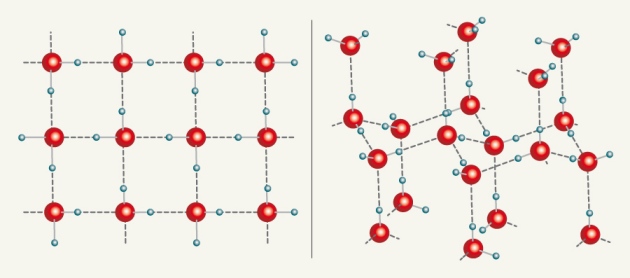New type of ice does not melt at room temperature and has a square crystal lattice.
Scientists under the direction of the Nobel laureate Andrei Heim placed water 1 nanometer thick between the graphene layers to get ice crystals of an unusual shape - two-dimensional squares. This new type of ice does not melt at room temperature. Scientists believe that such crystals can occur not only in graphene, but also exist in nature in the cracks of stones and soil.
On the left - the resulting lattice, on the right - the “classical” ice lattice.

Computer simulation has helped scientists to assume that water will adopt a two-dimensional square crystal lattice, if you hold it between sheets of graphene at high pressure. Scientists placed one microliter of water on a graphene sheet and pressed it to the second: the distance between the layers was no more than one nanometer. This occurred at room temperature. As a result, scientists have received ice.
')
In a layer of square ice, all atoms lie in the same plane with a right angle between each oxygen-hydrogen bond. The ice, which turned out to be the team of Andre Heim, contains two or three such layers. Graphene sheets should put pressure on the water for more than ten thousand atmospheres to get such a result.
Andrew Geim believes that a new type of ice can be used to develop graphene-based desalination filters.
Two-dimensional ice in the electron microscope. Speed increased.
On the left - the resulting lattice, on the right - the “classical” ice lattice.

Computer simulation has helped scientists to assume that water will adopt a two-dimensional square crystal lattice, if you hold it between sheets of graphene at high pressure. Scientists placed one microliter of water on a graphene sheet and pressed it to the second: the distance between the layers was no more than one nanometer. This occurred at room temperature. As a result, scientists have received ice.
')
In a layer of square ice, all atoms lie in the same plane with a right angle between each oxygen-hydrogen bond. The ice, which turned out to be the team of Andre Heim, contains two or three such layers. Graphene sheets should put pressure on the water for more than ten thousand atmospheres to get such a result.
Andrew Geim believes that a new type of ice can be used to develop graphene-based desalination filters.
Two-dimensional ice in the electron microscope. Speed increased.
Source: https://habr.com/ru/post/366637/
All Articles